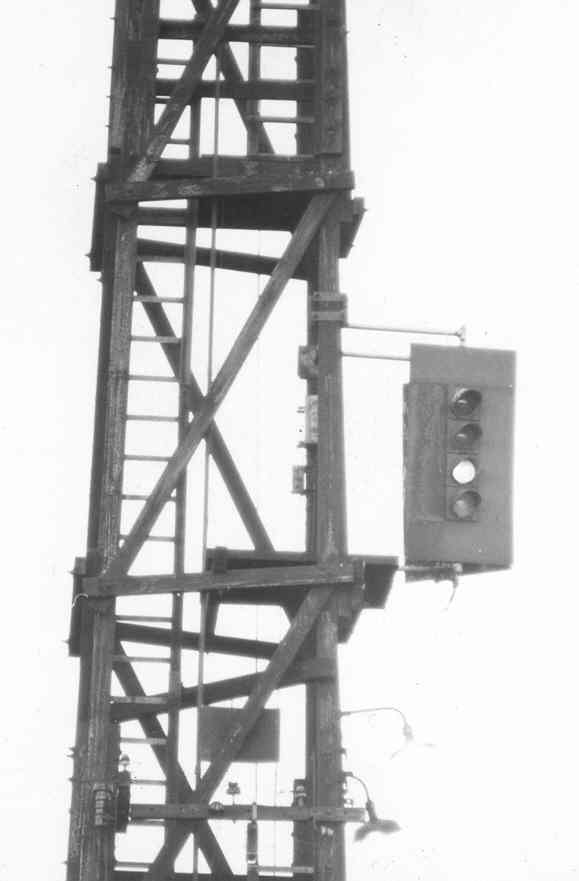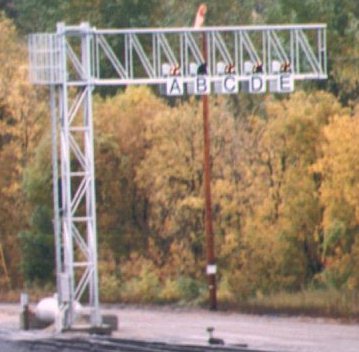

Hump Signals control the movements of trains in the yard, mostly when the trains are shoving into the yard. Some yards have an actual hump, like Bailey Yard (UP/North Platte NE), Argentine Yard (BNSF/Kansas City MO), or Conway Yard (NS/Pittsburgh PA), while others, like the former Western Maryland yard in Hagerstown MD, are flat and they would make up trains without the use of gravity.
Hagerstown MD -- CSX

A hump signal used in former Western Maryland
yard. The signal uses a standard auto type signal head with four
aspects. Although the Western Maryland did not have a hump in Hagerstown,
this signal nevertheless
controlled the engines making up trains.
B&W print photo from October 1973.
St Paul MN -- CP Rail

A unique signal used at the south end of "Pigs
Eye" yard in St Paul MN. Note that the signals used on the bridge are
dwarf PL's. The full size picture to the right was taken in 2001, the
other two in 2006. Wish I had then, the camera I use today :-)
A big thanks goes to
Mike Smeltzer of Chicago for the additional
info on these signals:
The signal you are inquiring
about is called a Shove Signal.
It is at the East end of Dunn Yard on the Arrival tracks and is for inbound road trains when they are shoving into the yard. The lights are used to protect the shove without having to have a man on the point of the shove or someone at the west-end watching the shove. If you look closely at each signal you will see 4 lights. Each light represents 4 car lengths. AAR specifications for a car length is 60ft. When the track is clear at the west-end all 4 lights will be on. Altho this doesn't mean that the track is clear it indicates that there is 16 car lengths open at the west end of the track. When a train shoves westward into the track, as the hind car hits the first circuit, 1 light will turn off, indicating that there are 12 car lengths to a stop. As the train keeps shoving and crosses the 2nd circuit, light 2 turns off indicating 8 car lengths left to a stop. Same for the 3rd circuit. When the 4th light turns off, the train stops.
If you look at the picture, tracks A, C and E have 16 car lengths clear at the west-end. Track D has 12 car lengths left. Track B has no room left. Track B is used as a lead for the hump so anytime they are humping all lights should be out as the track is occupied with the humper.
Disclaimers:
I love trains, and I love signals. I am not an expert. I do these pages because I love spending my time doing them - although I do a reasonable amount of research to make sure the information presented is accurate! :-) :-)
Please Note: Since the main focus of my two websites is railroad signals, the railfan guides are oriented towards the signal fan being able to locate them. For those of you into the modeling aspect of our hobby, my indexa page has a list of almost everything railroad oriented I can think of to provide you with at least a few pictures to help you detail your pike.
If this is a railfan page, every effort has been made to make sure that the information contained on this map and in this railfan guide is correct. Once in a while, an error may creep in, oooooooops, oh well! :-)
My philosophy: Pictures and maps are worth a
thousand words, especially for railfanning. Text descriptions only
get you so far, especially if you get lost or disoriented. Take
along good maps.... a GPS is OK to get somewhere, but maps are still
better if you get lost! I belong to AAA, which allows you to get
local maps for free when you visit the local branches. ADC puts
out a nice series of county maps for the Washington DC area, but their
state maps do not have the railroads on them. If you can find em,
I like the National Geographic map book of the U.S..... good, clear, and
concise graphics, and they do a really good job of showing you where
tourist type attractions are, although they too lack the railroads.
Other notes about specific areas will show up on that page if known.
BTW, floobydust is
a term I picked up 30-40 years ago from a National Semiconductor data
book, and means miscellaneous and/or other stuff.
Pictures and additional information is always needed if anyone feels
inclined to take 'em, send 'em, and share 'em, or if you have
something to add or correct.... credit is always given! BE NICE!!! Contact info
is here
Beware: If used as a source, ANYTHING from Wikipedia must be treated as being possibly being inaccurate, wrong, or not true.
RAILFAN GUIDES HOME
RAILROAD SIGNALS HOME
NEW 10-6-2006
Last Modified 03-Dec-2016